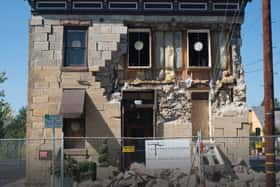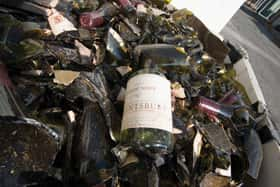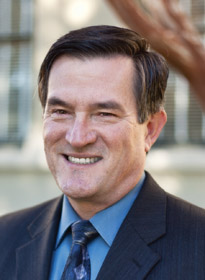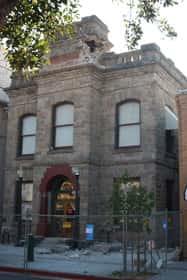 First the county shook apart, then it came together.
First the county shook apart, then it came together.
“It felt like a 747 was landing on the roof!” says Don Shindle, general manager of the Westin Verasa Napa Hotel. It was August 24, 2014, and a magnitude 6.0 earthquake had struck south Napa. He’d never been in an earthquake before. “You have no idea,” he says. “You wake up to this incredible shaking and movement and then you start to realize this is impacting the entire community.” On instinct, he did what everyone we talked to did. He made sure his family and pets were OK, checked the house for water and gas leaks, then rushed to check on his workplace. Arriving at the Westin, 10 minutes away, he found a world-class mess.
 “We had multiple sprinkler lines ruptured in the attic, a lot of water damage, drywall cracks, a lot of broken glassware and dishes, but nothing structural. The fantastic news is that no one—guest or staff—was hurt.” Immediately, people went into action and, to his amazement, without even having been called, by 4:45 a.m., there were 40 employees at the hotel ready to help. “We had a full hotel and by 9:30 a.m., hundreds of guests were relocated to alternate hotels in Sacramento, Petaluma and San Francisco. All our guests were very patient and cooperative.”
“We had multiple sprinkler lines ruptured in the attic, a lot of water damage, drywall cracks, a lot of broken glassware and dishes, but nothing structural. The fantastic news is that no one—guest or staff—was hurt.” Immediately, people went into action and, to his amazement, without even having been called, by 4:45 a.m., there were 40 employees at the hotel ready to help. “We had a full hotel and by 9:30 a.m., hundreds of guests were relocated to alternate hotels in Sacramento, Petaluma and San Francisco. All our guests were very patient and cooperative.”At Saintsbury Winery in Carneros, a little more than two miles from the epicenter, a red stain was spreading out from under the door of the “wine library,” where the old and special bottles are kept, when co-founder David Graves arrived. “I was the first one out here,” he says, “and the first thing I saw was the wine running under the door.” He pauses, contemplating the roomful of broken bottles. “That’s about 400 bottles of history.” Saintsbury had lost most of its library in an arson fire at a warehouse in Vallejo in 2005 (see “Don’t Go in the Cellar,” Oct. 2008), and those few surviving bottles were opened sparingly to make a point about style, ageability and such. Graves estimates the damage at about $50,000.

On an interesting note, the movement ripped a tear through the Saintsbury vineyard, and the U.S. Geological Service was over that Tuesday, and for several days afterward, making very precise measurements. They were fascinated to be able to map the displacement in the vineyards, where it’s so easy to see. “Some vines immediately started to lose their leaves,” says Graves, “because their roots had been torn away by the rupture.”
Tenants absorb their own losses
Back in town, at Oxbow Public Market, General Manager Bill LaLiberte was checking for gas leaks and sloshing through wine, vinegar, olive oil and broken glass. The building itself was fine and the damage was mostly suffered by vendors with products on the shelves. Cleanup was the challenge and he put in a call to the Napa Waste and Recycling, which placed a bin outside “within the hour.”
What impressed him was the way everyone pitched in to help. “You always hear how people come together during a crisis,” he says. “We saw tenants who had little damage coming in and helping tenants who had a great deal of damage. It was great to see people working together and getting things cleaned up. We were open for business during our normal hours Monday morning. With the exception of less product on the shelves, it would be really hard to know we really had an earthquake.”
Securing the infrastructure
Jack LaRochelle, city of Napa’s director of public works, was busy tracking leaks and buckling roads. There are upward of 400 miles of pipelines throughout Napa and, whereas public works crews typically repair about 120 leaks per year, this event caused 140 leaks to occur simultaneously. “Thanks to California WARN, which stands for Water and Wastewater Recovery Network, the very next day we had 10 crews from other agencies: East Bay Mud, Alameda Water District, city of Fairfield and others on hand to help. We were able to fix all 140 leaks in five days.” They kept water pressure stable and, out of 25,000 local customers, he says, only 1,800 lost water, and those only for a short time.
Roads and bridges were a major concern. “We had another six to eight locations in Browns Valley where there was a pretty pronounced crack that went in a straight line through five streets in a row, and about 250 locations where the sidewalks had buckled. They’ll have to tear all those out and redo them.”
He was also concerned about the bridge in Browns Valley because there was a buckling in the road on the approach. “The bridge is stable,” he says, “but the road has a little bump now.” The little footbridge between Clinton and Coombs had some cracks and, when engineers went down to inspect underneath, they noticed a fairly large anchor bolt had been sheered off, which will need major repair work in the future.
A literally huge problem was debris. “We ended up having something like 4,000 tons of debris that was hauled off,” he says. Some 10 percent of that was electronic—broken televisions and the like—so they set up an interim disposal services so people wouldn’t have to leave their broken objects on the curb.
LaRochelle says the million-gallon water tank in Browns Valley area suffered extensive damage. They were able to drain the water safely, maintaining two to three feet of water and protecting it with a temporary lid. The tank is now out of service and will take six months to a year to fix.
Minor damage defined
Larry Florin, director of housing, estimates that 130 homes had major damage and 1,100 had “minor damage”—which (news that would stagger a homeowner) is defined as 50 percent of the value of a home. So a person with a $700,000 home who suffers $350,000 worth of damage is classified, by FEMA as suffering “minor damage.”
Most of the 1,100 homes had “minor damage” in the $50,000 to $100,000 range. And less than 1 percent of residents have earthquake insurance. This, Florin (and everyone else we talked to) says, is because the high premiums and high deductible make it unaffordable to most individuals.
In what can only be termed “collateral damage,” residents whose homes were pronounced unsafe to live in after the quake found themselves looking for housing in a market where rentals are scarce and expensive. “The rental market in Napa has less than 2.5 percent vacancy—even before the earthquake,” says Florin. “Since the earthquake, some of the stock has been taken out for the short term. So what has been an incredibly tight rental market has become an impossible rental market.”
 Third District Superintendent Diane Dillon mentioned that the county, as an entity, was the single largest employer affected, and had, itself, rental issues, as so many of the county and federal offices were too damaged to work in. This meant that from the very start, county employees were working around the clock to stabilize the area, despite their own relocation issues. “We moved around 350 employees within 48 hours to new work space,” says Dillon. “We had to assemble at the Sheriff’s office and people went to work immediately.” She says county staff worked 12 to 15 hour days for the first two weeks. Fortunately, the county had purchased the former Dey Labs building in South Napa, and though it wasn’t ready for occupancy, it moved in. “We needed to put people back to work for the citizens of Napa County.”
Third District Superintendent Diane Dillon mentioned that the county, as an entity, was the single largest employer affected, and had, itself, rental issues, as so many of the county and federal offices were too damaged to work in. This meant that from the very start, county employees were working around the clock to stabilize the area, despite their own relocation issues. “We moved around 350 employees within 48 hours to new work space,” says Dillon. “We had to assemble at the Sheriff’s office and people went to work immediately.” She says county staff worked 12 to 15 hour days for the first two weeks. Fortunately, the county had purchased the former Dey Labs building in South Napa, and though it wasn’t ready for occupancy, it moved in. “We needed to put people back to work for the citizens of Napa County.”Organizing from the top down
 Mark Luce, chair of the Board of Supervisors of Napa County, got the call at 5:30 a.m. that the Emergency Operations Center was open at the sheriff’s facility because “downtown was out.” He shortly found out that that meant “literally.”
Mark Luce, chair of the Board of Supervisors of Napa County, got the call at 5:30 a.m. that the Emergency Operations Center was open at the sheriff’s facility because “downtown was out.” He shortly found out that that meant “literally.”“Our administration building, county courthouse and all the county and federal buildings were hardest hit,” he says. “So we began the effort to assemble the Emergency Operations Center and, by the time I got there, most people had shown up.” Emergency operations aren’t spontaneous, but they are systematically planned and employees are regularly drilled for emergencies. “Folks at the Operations Center were people who’ve been trained on the Systematic Emergency Management System,” says Luce. “Each of them took on a different role for which they’d been trained. So our planner became our ‘incident commander.’ Some were gathering data and information and doing bookkeeping and logistics, while others were managing communications. Everybody had a role.”
The county has seen and responded to flood emergencies, he notes, but an earthquake is a whole different beast. “With a flood,” says Luce, “you see it coming six or 10 hours in advance. With an earthquake, it’s all at once—gas leaks, water leaks, closed roads, power loss—and you have to work with everybody to figure out what’s going on.”
He has only praise for the first responders. “PG&E was awesome,” he says. “It had several hundred employees from around the Bay Area show up. It had a sensitive ‘sniffer truck’ that could drive up and down the streets and smell gas. It actually identified a house had been abandoned, after the quake, and it turned out there was a gas leak in the house and, if PG&E hadn’t discovered it, there could have been an explosion. So it was great.”
County costs begin to mount
 “One of the first things we did was hire a FEMA consultant,” says Dillon. “And our insurance agency hired people to come in and start boxing things immediately to avoid further water damage. So bingo, bingo, bingo, you have all these immediate costs.” Suddenly, categorization of costs becomes critical to the complicated process of getting FEMA reimbursement. So staff needs to track all costs carefully. “One of the things we’re trained on is how to keep track of expenses. For example, guys who are going out to repair road—they do that every day. But if they’re repairing earthquake damage, they have to document that."
“One of the first things we did was hire a FEMA consultant,” says Dillon. “And our insurance agency hired people to come in and start boxing things immediately to avoid further water damage. So bingo, bingo, bingo, you have all these immediate costs.” Suddenly, categorization of costs becomes critical to the complicated process of getting FEMA reimbursement. So staff needs to track all costs carefully. “One of the things we’re trained on is how to keep track of expenses. For example, guys who are going out to repair road—they do that every day. But if they’re repairing earthquake damage, they have to document that."FEMA has three categories: public reimbursement for roads, public buildings, businesses and individual assistance. There are levels it recognizes for each.” Individual assistance, says Dillon is the most challenging so far. “We don’t have the kind of destruction that happens as when a tornado hits, for example. This isn’t that kind of a disaster, in terms of FEMA.”
When we read of other disasters—neighborhood-leveling tornados, catastrophic fires and floods—it seems FEMA is there to provide relief to those who’ve lost their homes and businesses, and we assume people will be all right and turn our attention elsewhere. Here, up close, it quickly became apparent that receiving relief isn’t so simple.
Napa opened the Local Assistance Center on Monday after the earthquake, in the old Vallergas building at the base of First Street and Silverado Trail, to lines around the block looking for help. By mid-October, volunteers had handled 4,060 calls, more than 2,100 in-person visits and 50 to 80 new inspection requests per day. Barry Martin, public information officer for the city of Napa, said it was uncertain how or what help would be available to individuals.
“I’ve volunteered down at the Local Assistance Center,” says First District Supervisor Brad Wagenknecht, “and when people saw that we got a federal declaration, they’d say, ‘I’ve come for my FEMA.’” He says they’re likely to be disappointed. “Whereas after the minor earthquake in 2000 FEMA came in and wrote checks, the picture now is very different.”
“What’s happened,” says Wagenknecht, “is that there have been some very high-profile disasters—and billions and billions have gone out. Now the federal government is saying, ‘We’re not Santa Claus anymore!’ So it’s tightened the rules all around.”
That said, Wagenknecht stresses that Napa’s legislation delegation—Congressman Mike Thompson and Senators Dianne Feinstein and Barbara Boxer—has been working tirelessly with President Obama and FEMA on the county’s behalf.
Vintners step up
“It’s interesting because this is a moment when you turn to government agencies and you realize they didn’t even have a home,” says Russ Weis, chairman of Silverado Vineyards and this year’s chairman of the board of directors of Napa Valley Vintners. "They’re scrambling around trying to get to some basic operating level. And you also realize, wait a second, you don’t donate money to governments anyway, so we realized we needed to do something as vintners, and we were prepared to do something financially, but woefully unprepared to do something structurally. We’re not a disaster relief organization. So that began the search for what pretty quickly became a strategic alliance with the Community Foundation Napa Valley."
They decided that the first tranche would be to the charitable organizations (Salvation Army, for example, which was out there every day handing out meals) who are on the “front lines” and who are going to need cash right away to be able to continue to help. The second level was to reach past the charitable organizations to individuals in dire need, “because the worst that can happen is you’ve lost your house and you can’t come up with a first and last and a security deposit, and maybe you can’t go to work anymore, because the business is closed. So you’re not getting any money anymore.”
“Unfortunately,” he says, “in these situations, the people who can afford it the least seem to get hit the hardest.”
He reflects that because of the interconnected nature of business, work, home and security, it seems most important to get the whole community up and running again. “You can look around the world and the best responses to this kind of natural disaster is when the community gets up and running. But it’s tricky because you have to figure out the rules of who gets what and why.”
At press time in mid-October, the total damages had not been assessed, nor had the amount of possible reimbursement by FEMA. As for contributions, Terence Mulligan, executive director of Napa Valley Community Foundation, says the amount contributed to-date to the Disaster Relief Fund by organizations and individuals was “fast approaching $400,000.”
Lessons learned
“Despite all the talk that we hear and people in my position pass along about preparedness,” says Martin, “most people continue to not be prepared, and that’s a problem. This quake, while it was extremely damaging here in Napa, is still not ‘the big one.’”
The information is all out there, he says, just Google, “earthquake preparedness.” “The idea of being prepared for 72 hours, with water, food and batteries, people should take that seriously. When your dwelling is destroyed, or is in such a mess that you can’t function, a lot of people are left with limited options. In the big one, your car might be destroyed, the roads might be destroyed, and you might need to be able to survive where you are.”
“There’s nothing to say it won’t happen again,” says Wagenknecht. “The injuries and deaths have happened because people had things by their bed that could fly off and land on them. We don’t want to spend our lives planning for disaster, but it’s important to spend a little bit of time thinking about it and to do something about it.”
When you think that this might happen again and start to be tempted to think maybe earthquake country isn’t the best place in the world to live, think again. As Graves points out, the geography, terroir and character of this place has been made over millions of years by seismic activity between the North American and Pacific plates. “The volcanic soils are the product of a hot spot that moved south to north along the plate margin over millions of years,” he says. “So if you’re growing lovely Cabernet on Howell Mountain, you’re growing it there because of the volcanic soils that are there because of this whole North America/Pacific Plate junction.” Earthquakes are part of the natural process that makes this place and what it produces unique.
Looking to the future
“The industries that Napa is known for—wine and tourism—will rebound from this,” says Larry Florin. “We’re pretty optimistic as far as the Napa economy is concerned. Overall, we’ll do a lot better than other places would.” Helping Napa’s recovery is, as people always say when talking about this community they love, the generous nature of the community.
Napa Mayor Jill Techel is proud of the city of Napa’s response to disaster. “We’re learning lessons from other communities that have had damage from other earthquakes,” she says. “And when you walk through Napa, you’ll see it’s active.” As to the ongoing redevelopment of downtown, she’s optimistic. “I think some things will speed up and some things will go slower. Right before the earthquake, we approved the Archer Hotel, and that’s moving forward.”
Todd Zapolski, developer of Napa Center, which includes construction of the 183-room, six-story Archer Hotel, acknowledges that the damage, the loss of interim tenants and the cost to make his property safe may slow his progress, but will not stop it. “The future is going to be stronger than ever. We have a vibrant opportunity to kickstart our overall project with new construction beginning for our hotel within the next month. So it’ll be very positive to see cranes and forward movement. It’s due to open late in 2016. It’ll be an amazingly different world. I think we’re even more of a phoenix for energizing the downtown core than we were before.”
“I think the people of Napa ought to be proud of themselves for how they responded to this in such a positive way,” says LaRochelle. “Sometimes when we’re shaken, literally and figuratively, what’s inside of us comes out. And what came out was very positive. What I saw was nice.”
Help for Those Displaced
Tenants Together has compiled the key information into a guide for Napa tenants impacted by the earthquake.
“The stories are heartbreaking,” commented Leah Simon-Weisberg, legal director of Tenants Together, California’s statewide organization for renters’ rights. “The damage and displacement is bad enough, but it’s made worse by the fact that there’s not a single resource out there for tenants to lay out clearly exactly what their rights are after such a disaster. We’re releasing our guide to fill that void.”
Tenants Together collaborated with Cope Family Center in Napa and Fair Housing Napa Valley to put together the information in the guide for tenants. Its legal team exhaustively researched the applicable law and produced the fact sheet.
The guide contains answers to each of the following questions and more:
• What does it mean if my apartment building was red, yellow, or green tagged?
• Am I entitled to relocation benefits?
• Are there any other resources available to me?
• Can I reenter the building to get my belongings?
• Is my lease terminated because of earthquake damage?
• Do I still need to pay rent if my unit has been tagged?
• Can the landlord raise my rent to make earthquake repairs?
• Can the landlord take money for earthquake damage repairs out of my security deposit?
Tenants can visit www.tenantstogether.org/earthquakeanswers, for more information and to request a copy of the Guide.
Napa Valley Rocks!
By Julie Fadda Powers
 On August 25, Jayson Rice, who lives with his wife, Brianne, and two sons in American Canyon, posted a wonderful vision on his Facebook page. He wanted to be able to do something to help victims of the August 24 earthquake that would involve the community and spread joy. He foresaw a music, wine and food event and named the idea “Napa Rocks…and We Keep Rolling.” What happened from there is a true testament to a community coming together.
On August 25, Jayson Rice, who lives with his wife, Brianne, and two sons in American Canyon, posted a wonderful vision on his Facebook page. He wanted to be able to do something to help victims of the August 24 earthquake that would involve the community and spread joy. He foresaw a music, wine and food event and named the idea “Napa Rocks…and We Keep Rolling.” What happened from there is a true testament to a community coming together.“The day of the quake, we didn’t have much damage where I live. So I reached out to friends to make sure they were OK or see if they needed any help. But I wasn’t getting much of a response. I was frustrated because I was unable to help. I went to work the next day and it was still bothering me. That’s when I came up with an idea for a fund-raiser. I posted it on my Facebook page and woke up the next day to so many texts, emails, calls and messages from people who wanted to be involved,” says Rice.
“That Friday, we got together with the CEO of the Napa Chamber of Commerce, the CEO of the Napa Downtown Association and the vice mayor of American Canyon, among others. That’s when the organizers of BottleRock called and said they wanted to be involved.”
Jayson’s idea bloomed from a single-day event into four days of fund-raising activities. “Our goals were to lift Napa’s spirits, raise funds for those affected and to let people know that Napa was open for business,” says Rice. He estimates working 50 hours per week over the following month (on top of his full-time job) to help make things happen, and credits the many other people—volunteers, government, businesses, entertainers and more—who donated their time and services.
“I think a lot of people had a similar idea as mine, so we were able to put everything under a single umbrella,” he continues. The results were outstanding, with the first event, called “Nourish Napa!” on Thursday, September 25, bringing in approximately 250 people for wine, food and music presented by some of Napa’s top chefs and wineries, as well as a live auction. Events throughout downtown continued on Friday and Saturday. “For ‘Napa Live!’ on Saturday, I booked 14 bands in nine different venues. Walking around that night, seeing how many people were out and getting feedback from the businesses involved was proof that Napa was definitely open,” says Rice. “At the main concert [Napa Valley Rocks!] at Napa Valley Expo on Sunday [which featured Michael Franti and Spearhead, Afrolicious and Grass Child], I was so enamored by the crowd, just looking at all the smiles and people having a great time. I teared up onstage watching everyone.”
An after-concert at City Winery featured Rice’s band, Davenport, along with The Iron Heart and The Buttercream Gang. “Everyone was talking about how well put together everything was,” he says. “It was definitely good.”
Proceeds from all the events went directly to The Napa Valley Community Disaster Relief Fund, managed by Napa Valley Community Foundation, and were estimated (at press time) to have exceeded $150,000.



